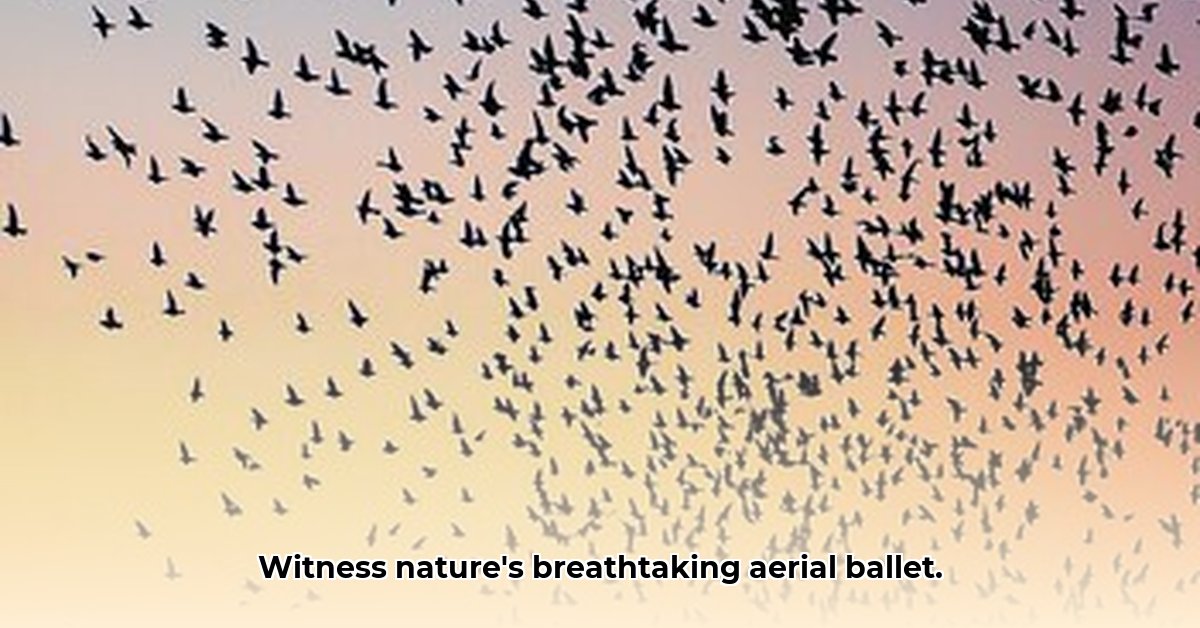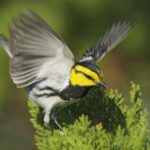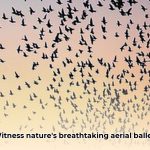Have you ever been captivated by a seemingly chaotic yet perfectly synchronized dance of thousands of birds in the sky? This breathtaking phenomenon is called a murmuration, and it’s more than just a pretty sight. It’s a complex marvel of nature, driven by physics, biology, and survival. We’ll explore the science behind these mesmerizing displays, uncover the secrets of their coordination, and delve into how scientists are drawing inspiration from this natural wonder to innovate in robotics and beyond. Furthermore, we’ll examine the importance of conservation efforts to protect these incredible birds and their habitats.
The Science Behind the Swirl: Unveiling the Secrets of Murmurations
Imagine standing beneath a vast expanse of sky as the sun begins to set. A dark cloud forms on the horizon, growing larger and more defined with each passing moment. But this isn’t an ordinary cloud; it’s a murmuration—a swirling, ever-changing mass of thousands of starlings, moving in perfect unison. The sight is both awe-inspiring and humbling, leaving many to wonder: what drives this incredible phenomenon?
The Seven-Neighbor Rule: A Simple Key to Complex Behavior
At the heart of the murmuration’s mesmerizing movements lies a surprisingly simple principle: the “seven-neighbor rule.” Scientists have discovered that each starling primarily focuses on the movements of its seven closest neighbors, adjusting its own flight to match their speed and direction. This seemingly basic rule, when replicated across thousands of birds, creates a chain reaction that results in the flock’s fluid, dynamic motion.
Think of it as a decentralized network, where each individual contributes to the overall behavior without a central leader. This self-organizing system allows the murmuration to adapt quickly to changing conditions, evade predators, and maintain its cohesive structure.
Visual Acuity and Reaction Time: Essential for Coordination
Beyond the seven-neighbor rule, starlings possess exceptional visual capabilities that enable them to navigate the crowded skies with remarkable precision. Their wide field of view, combined with rapid processing speeds, allows them to constantly monitor the positions of their flockmates and react instantly to avoid collisions.
These adaptations highlight the intricate interplay between biology and behavior in murmurations. The birds’ physical attributes are perfectly suited to their social environment, allowing them to thrive in large, dynamic groups.
Why Gather? Unraveling the Evolutionary Advantages
Scientists believe that murmurations serve several key purposes, primarily related to predator avoidance and enhanced foraging efficiency.
For predators like hawks and falcons, singling out an individual starling from a dense, swirling flock is incredibly challenging. The constant movement and changing shape of the murmuration create a visual illusion that confuses predators and makes it difficult to target a single bird. This “safety in numbers” strategy significantly increases the starlings’ chances of survival.
Additionally, murmurations may facilitate information sharing and collective decision-making regarding foraging opportunities. By gathering in large numbers, starlings can pool their knowledge of the surrounding landscape and identify the best feeding grounds more efficiently.
Nature’s Blueprint: How Murmurations Inspire Innovation
The elegance and efficiency of murmuration have captured the attention of scientists and engineers seeking to create innovative solutions in various fields, including robotics, computer science, and urban planning.
Swarm Robotics: Mimicking Nature’s Coordination
One of the most promising applications of murmuration research is the development of swarm robotics. By studying the principles of self-organization and decentralized control that govern starling flocks, researchers are creating robots that can work together in a coordinated manner to perform complex tasks.
Imagine a swarm of robots working together to clean up an oil spill, inspect a bridge, or deliver packages in a crowded city. The possibilities are endless, and the potential benefits are enormous.
Collective Intelligence: Harnessing the Power of the Crowd
Murmurations also offer valuable insights into the nature of collective intelligence. By understanding how individual birds contribute to the overall behavior of the flock, scientists can develop algorithms that enable computers to solve problems more effectively.
This research could lead to breakthroughs in areas such as data analysis, pattern recognition, and artificial intelligence.
Guardians of the Skies: Protecting Starlings and Their Habitat
While the science of murmurations is fascinating, it’s important to remember that these amazing displays are also a vital part of our natural heritage. Starlings play a crucial role in the ecosystem, and their populations are facing increasing threats from habitat loss, pesticide use, and climate change.
Habitat Conservation: Preserving Roosting Sites and Foraging Grounds
Protecting starling habitats is essential to ensuring the survival of these birds and their spectacular murmurations. Conservation efforts should focus on preserving and restoring wetlands, open fields, and other areas that provide suitable roosting sites and foraging grounds.
Responsible Land Management: Minimizing Human Impact
Reducing pesticide use and promoting sustainable agricultural practices can also help to protect starling populations. By minimizing the negative impacts of human activities on the environment, we can create a healthier world for starlings and other wildlife.
The Ethical Imperative: Balancing Progress and Preservation
As we continue to learn from murmurations and apply their principles to new technologies, it’s crucial to consider the ethical implications of our actions. We must strive to develop and use these technologies in a responsible manner, ensuring that they benefit both humanity and the environment.
Weighing the Promise and Peril of Murmuration-Inspired Technology
| Technology Area | Potential Benefits | Potential Risks | Mitigation Strategies |
|---|---|---|---|
| Swarm Robotics | Enhanced efficiency, adaptability, resilience in diverse tasks | System failure, unpredictable behavior, loss of control | Redundancy, robust control algorithms, fail-safes, human oversight |
| Data Analysis | Improved understanding of collective intelligence | Bias in algorithms, data privacy concerns | Diverse datasets, rigorous testing, data anonymization |
| Environmental Monitoring | Efficient, wide-area surveillance, reduced environmental impact | Unintended data collection, privacy violations | Clear protocols, robust security measures, legal framework |
| Military Applications | Enhanced situational awareness, targeted strikes | Autonomous weapons, escalation of conflict, lack of accountability | International treaties, ethical guidelines, strict regulations |
A Call to Action: Celebrate and Protect the Wonder of Murmurations
Starling murmurations are a testament to the power and beauty of nature. By understanding the science behind these amazing displays, we can gain valuable insights into the workings of the natural world and develop innovative solutions to some of humanity’s greatest challenges.
However, we must also recognize the importance of protecting these incredible birds and their habitats. By supporting conservation efforts and adopting responsible land management practices, we can ensure that future generations will have the opportunity to witness the wonder of murmurations for themselves.
Key Takeaways:
- Starling murmurations are breathtaking displays of coordinated flight, primarily driven by predator avoidance.
- Simple rules followed by individual birds create complex, emergent patterns.
- These spectacular events typically happen at dawn and dusk near wetlands, open fields, and roosting sites. Habitat loss directly impacts murmuration sites.
- Conservation efforts are crucial to protect both starling populations and their vital habitats. Population declines threaten the very existence of these amazing displays.
- Research into murmuration dynamics informs our understanding of collective intelligence and has potential applications in robotics and artificial intelligence.
The Murmuration’s Acoustic Dimension: Deciphering the Symphony of Flight
Imagine a swirling, living cloud, a mesmerizing ballet of thousands of starlings moving in perfect synchrony. While we often focus on the visual spectacle, could there be an acoustic dimension to this breathtaking phenomenon? How much do visual or aural cues govern flight?
Visual Cues: The Foundation of Coordination
Scientists have long believed that visual cues play a primary role in murmuration dynamics. The “seven-neighbor rule,” where each bird focuses on the movements of its immediate neighbors, provides a compelling explanation for the flock’s cohesive behavior.
But could sound also be playing a role? Do the birds communicate acoustically? Could the cacophony of chirps and calls influence flock cohesion and their defense against predators? It’s a possibility scientists are actively investigating.
The Unsung Role of Acoustics: A Symphony of Chirps and Calls
Research is emerging that suggests subtle acoustic cues might indeed play a role in murmuration dynamics. The constant chattering and vocalizations of starlings could be more than just background noise; they could be a form of communication that helps the flock maintain its structure and respond to threats.
Imagine a ripple effect; a sudden change in vocalizations could trigger a shift in the flock’s direction. This hypothesis needs more investigation, using sophisticated sound recording and analysis techniques. Researchers are working to untangle these intricate interactions.
Testing the Acoustic Hypothesis: Unraveling the Soundscape of Murmurations
To test the acoustic hypothesis, scientists are using advanced recording equipment to capture the soundscape of murmurations. By analyzing the frequency, intensity, and patterns of starling vocalizations, they hope to identify specific signals that correlate with changes in flock behavior.
This research is challenging, as it requires separating the relevant acoustic signals from the ambient noise of the environment. However, the potential insights are significant.
Implications of Acoustic Communication: A New Understanding of Collective Behavior
If confirmed, the importance of acoustic communication in starling murmurations would have far-reaching implications. It would not only deepen our understanding of collective animal behavior but also provide new insights for designing autonomous systems.
Imagine drones that work together like murmurations, responding instantly to changes in their environment based on acoustic signals. The possibilities are endless.
Unanswered Questions: The Future of Murmuration Research
There’s so much left to discover. The exact nature of acoustic signals within murmurations, and how they affect decision-making, are still being explored. “Murmuration dynamics remain fascinating,” said [Dr. Andrew Reynolds, Senior Research Scientist], [Rothamsted Research]. We continue to be amazed by nature’s solutions. Understanding this intricate system not only satisfies our curiosity but may also inspire groundbreaking engineering advancements.
PMC Link
Unlocking the Secrets of Starling Flight: Proven Tactics for Diverse Environments
Imagine a swirling, living cloud, a dark mass morphing and twisting against the twilight sky. That’s a murmuration – thousands of European starlings weaving an intricate, aerial ballet. But how do they do it? This isn’t just beautiful; it’s a fascinating example of proven tactics for understanding starling flight dynamics in diverse environments.
What makes these aerial displays so mesmerizing? It’s the sheer scale and seamless coordination. Each bird seems to sense the movements of its neighbors, adjusting its course instantly to avoid collisions and maintain the flock’s overall shape.
The Physics of Flight: More Than Meets the Eye
The beauty of a murmuration isn’t just visual; it’s a testament to aerodynamic principles. Each starling is a tiny, self-propelled aircraft, navigating a complex three-dimensional space. We employ proven tactics for understanding starling flight dynamics in diverse environments by examining these principles. How do they avoid mid-air collisions? It’s a testament to their efficient maneuvering and remarkable perception.
Think about the forces at play: lift, drag, and thrust. These birds are masters of minimizing drag. Their streamlined bodies and precise wing movements help them weave through the crowd with remarkable ease. Observing these forces in action provides crucial information for understanding the dynamics of the entire flock.
The Biology of Cooperation: Individual Rules, Collective Outcomes
While the physics are impressive, it’s the biology that truly makes the murmuration possible. Scientists have identified simple rules governing individual bird behavior, yet the collective outcome is surprisingly complex. Each bird seems to follow a few key principles:
- Maintaining distance from its neighbors: Avoid overcrowding and collisions.
- Matching the speed and direction of nearby birds: Aligning flight paths for smoother movement.
- Staying close to the flock’s center: Ensuring cohesion and group unity.
These “simple rules” are often likened to the principles behind “Boids,” a computer model simulating flocking behavior. But murmuration is far more intricate than even the most sophisticated models can replicate. The subtle nuances of bird-to-bird communication remain an area of active research and can help better create proven tactics for understanding starling flight dynamics in diverse environments.
Technological Insights: Learning from Nature
The elegance of murmuration has sparked interest in engineering and robotics. Imagine drone swarms mimicking the coordinated movements of a starling flock. Researchers are actively exploring bio-inspired designs, hoping to apply the principles of murmuration to improve efficiency and maneuverability in autonomous systems. This is yet another way to refine proven tactics for understanding starling flight dynamics in diverse environments.
However, ethical considerations must also be addressed. While mimicking nature can yield significant technological advancements, we must be mindful of the potential ecological and societal implications.
Unanswered Questions and Future Directions
Despite significant progress, many mysteries of murmuration remain. How exactly do starlings communicate with each other? What factors influence the shape and size of a murmuration? These and many other questions necessitate further research. Analyzing murmuration across diverse environments, from coastal regions to inland plains, will provide a richer understanding of this fascinating phenomenon, helping us create successful proven tactics for understanding starling flight dynamics in diverse environments.
https://www.nature.com/articles/d43978-022-00067-4
- Discover Life in a Medieval Castle: Beyond Battles & Banquets: Unveiling Daily Life - August 2, 2025
- Scipio Africanus: Hannibal’s Nemesis: Rise, Fall, and Legacy - August 2, 2025
- Unveiling Superorganisms: Are Ant Colonies One Mind? - August 2, 2025














